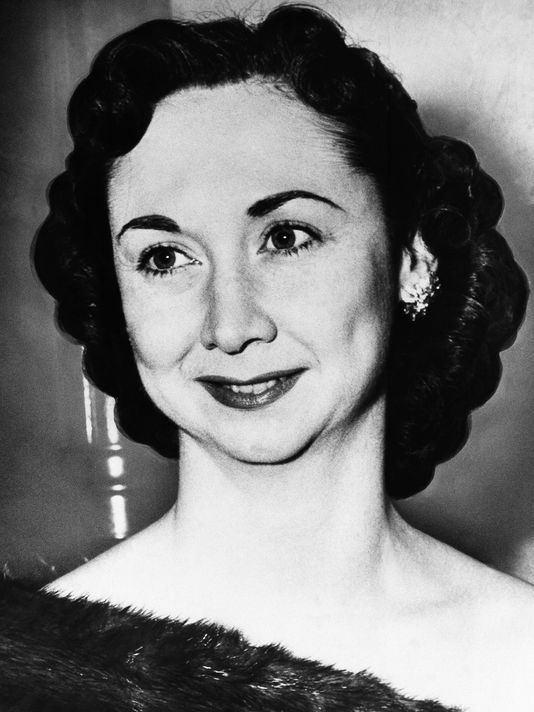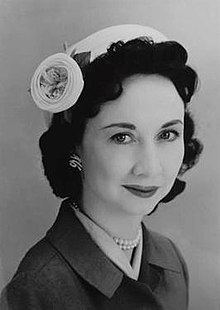Nationality American Name Dorothy Kilgallen | Role Journalist Books Murder One | |
 | ||
Full Name Dorothy Mae Kilgallen Born July 3, 1913 ( 1913-07-03 ) New York, New York, U.S. Cause of death Apparent alcohol and drug combination overdose Resting place Gate of Heaven CemeteryHawthorne, New York Occupation Media personality, author, journalist, panelist Children Kerry Kollmar, Jill Kollmar, Richard Kollmar Jr. Movies and TV shows What's My Line?, Sinner Take All, Fly Away Baby Similar People | ||
Trace Evidence - 054 - The Mysterious Death of Dorothy Kilgallen - Part 1
Dorothy Mae Kilgallen (July 3, 1913 – November 8, 1965) was an American journalist and television game show panelist. She started her career shortly before her 18th birthday as a reporter for the Hearst Corporation's New York Evening Journal after spending two semesters at the College of New Rochelle. In 1938, she began her newspaper column, "The Voice of Broadway", which eventually was syndicated to more than 146 papers. She became a regular panelist on the television game show What's My Line? in 1950.
Contents
- Trace Evidence 054 The Mysterious Death of Dorothy Kilgallen Part 1
- Dorothy kilgallen the reporter who knew too much
- Early life and career
- Whats My Line
- Sinatra feud
- Sam Sheppard murder trial
- Defense of criminal defendant Lenny Bruce
- Kilgallen and the Kennedy assassination
- Death
- Legacy
- Filmography
- References

Kilgallen's columns featured mostly show business news and gossip, but also ventured into other topics such as politics and organized crime. She wrote front-page articles on the Sam Sheppard trial and later the John F. Kennedy assassination.

Dorothy kilgallen the reporter who knew too much
Early life and career

Kilgallen, born in Chicago, was the daughter of newspaper reporter James Lawrence Kilgallen (1888–1982) and his wife, Mae Ahern (1888-1985). She was Roman Catholic. Dorothy had one sibling, a sister six years her junior named Eleanor (1919-2014). The family moved to various regions of the United States until 1920, when the International News Service hired James Kilgallen as a roving correspondent based in New York City. The family settled in Brooklyn, New York. Kilgallen was a student at Erasmus Hall High School. After completing two semesters at The College of New Rochelle, Kilgallen dropped out to take a job as a reporter for the New York Evening Journal. The newspaper was owned and operated by the Hearst Corporation, which also owned International News Service, her father's employer.

In 1936 Kilgallen competed with two other New York newspaper reporters in a race around the world using only means of transportation available to the general public. She was the only woman to compete in the contest and came in second. She described the event in her book Girl Around The World, which is credited as the story idea for the 1937 movie Fly-Away Baby starring Glenda Farrell as a character partly inspired by Kilgallen.
During a stint living in Hollywood in 1936 and 1937, Kilgallen wrote a daily column primarily read in New York, which provoked a libel suit from Constance Bennett, "who in the early thirties had been the highest paid performer in motion pictures", according to a Kilgallen biography, "but who was [in 1937] experiencing a temporary decline in popular appeal."
Back in New York in 1938, Kilgallen began writing a daily column, the "Voice of Broadway", for Hearst's New York Journal-American, which the corporation created by merging the Evening Journal with the American. The column, which she wrote until her death in 1965, featured mostly New York show business news and gossip, but also ventured into other topics such as politics and organized crime. The column eventually was syndicated to 146 newspapers via King Features Syndicate. Its success motivated Kilgallen to move her parents and Eleanor from Brooklyn to Manhattan, where she continued to live with them until she got married.
On April 6, 1940, Kilgallen married Richard Kollmar, a musical comedy actor and singer who had starred in the Broadway show Knickerbocker Holiday and was performing, at the time of their wedding, in the Broadway cast of Too Many Girls.
Early in their marriage, both Kilgallen and Kollmar launched careers in network radio, Kilgallen with her radio program Voice of Broadway, which was broadcast on CBS during World War II, and Kollmar with a long stint in the nationally syndicated crime drama in which he played Boston Blackie.
Beginning in April 1945, Kilgallen and Kollmar co-hosted a WOR-AM radio talk show, Breakfast With Dorothy and Dick, from their 16-room apartment at 640 Park Avenue. The show followed them when they bought a neo-Georgian townhouse at 45 East 68th Street in 1952. The radio program, like Kilgallen's newspaper column, mixed entertainment with serious issues. Kilgallen and Kollmar continued doing the show from their home until 1963, long after the terminations of other radio shows on which each had worked without the other.
Kilgallen was among the notables on the guest list of those who attended the coronation of Queen Elizabeth in 1953. Kilgallen's articles about the coronation won her a Pulitzer Prize nomination.
What's My Line?
Kilgallen became a panelist on the American television game show What's My Line? in 1950, which was telecast from New York City on the CBS television network from 1950 to 1967. She remained on the show for 15 years (until her death).
Sinatra feud
Though Kilgallen and Frank Sinatra were fairly good friends for several years and were photographed rehearsing in a radio studio for a 1948 broadcast, they had a falling out after she wrote a multipart 1956 front-page feature story titled "The Frank Sinatra Story". In addition to the New York Journal-American, Hearst-owned newspapers across the United States ran the story. Thereafter Sinatra made derogatory comments about Kilgallen's physical appearance to his audiences at nightclubs in New York and Las Vegas, though he stopped short of mentioning her name on television or during interviews for magazines and newspapers.
Sam Sheppard murder trial
Kilgallen covered the 1954 murder trial of Sam Sheppard, a doctor (whose specialty was osteopathic neurosurgery) who was convicted of bludgeoning his wife to death at their home in the Cleveland suburb of Bay Village.
The New York Journal-American carried the banner front-page headline that she was "astounded" by the guilty verdict because of what she argued were serious flaws in the prosecution's case. At the time of the Cleveland jury's guilty verdict in December 1954, Kilgallen's sharp criticism of it was controversial and a Cleveland newspaper dropped her column in response. Her articles and columns in 1954 did not reveal all she had witnessed in the Cuyahoga County Court of Common Pleas. Nine years and some months after the verdict and the judge's immediate pronouncement of the life sentence, she revealed publicly, at an event that was held at the Overseas Press Club in New York, that the judge had told her before the start of jury selection that Sheppard was "guilty as hell."
Attorney F. Lee Bailey, who was working on a habeas corpus petition for his client Sheppard, attended the Overseas Press Club event, heard what Kilgallen told the crowd, and then asked her privately if she would help him. "Some days later," as Bailey wrote in his memoir The Defense Never Rests, "we obtained a deposition from Dorothy that was inserted into the petition submitted to" Carl Andrew Weinman, judge for the United States District Court for the Southern District of Ohio. Bailey also included in the habeas corpus petition a statement from Edward Murray, who had worked in 1954 as a court clerk at the Cuyahoga County Court of Common Pleas. Similar to Kilgallen's statement, Murray's statement indicated that the original Sheppard judge, Edward J. Blythin, had declared Sheppard guilty even before the grand jury's August 17, 1954, indictment of Sheppard.
In July 1964, four months after the Overseas Press Club event where Kilgallen broke her silence about the deceased Judge Blythin, Judge Weinman of the federal court granted Bailey's habeas corpus petition, Sam Sheppard was released from prison amid much newspaper publicity, and Sheppard met Kilgallen at a "late-night champagne party" (as described by Bailey in The Defense Never Rests) in Cleveland. After Kilgallen's death, Sheppard was retried and acquitted.
Defense of criminal defendant Lenny Bruce
In 1964, Kilgallen was one of four witnesses who testified for the defense of comedian Lenny Bruce, who was being prosecuted for obscenity in New York City.
Kilgallen and the Kennedy assassination
Kilgallen was publicly skeptical of the conclusions of the Warren Commission's report into the assassination of President Kennedy and wrote several newspaper articles on the subject. She obtained a copy of Jack Ruby's testimony to the Warren Commission, which she published in August 1964 on the front pages of the Journal American, the Philadelphia Inquirer, the Seattle Post Intelligencer, and other newspapers. Most of that testimony did not become officially available to the public until the commission released its 26 volumes of hearings and exhibits in November 1964, around the time of the first anniversary of the assassination.
Death
On November 8, 1965, Kilgallen was found dead on the third floor of her five-story Manhattan townhouse. Her death was determined to be caused by a fatal combination of alcohol and barbiturates. The autopsy ruled out a heart attack, which was a possibility that her father James Kilgallen, still working as a newspaper reporter at age 77, had raised when other reporters had interviewed him immediately after the discovery of her body.
Dorothy Kilgallen and Richard Kollmar had been married for 25 years, and they had three children.
On November 11, Kilgallen's parents, husband, and children were among nearly 2,600 people in attendance at her funeral Mass, held at her parish church, St. Vincent Ferrer. Among those attending were John Daly, Arlene Francis, Ed Sullivan, movie producer Joseph E. Levine, Bob Considine, and Joan Crawford. Kilgallen was interred at Gate of Heaven Cemetery in New York.
On the following Sunday night's What's My Line?, telecast on November 14, To Tell the Truth regular panelist Kitty Carlisle, who had been a guest panelist on three previous episodes of What's My Line?, temporarily filled in for Kilgallen. She said on-camera that although she was occupying Kilgallen's seat, "no one could ever possibly take her place. Goodnight, Bennett."
Kilgallen has a star on the Hollywood Walk of Fame on Hollywood Boulevard. The archives of the Hollywood Chamber of Commerce list her as one of the 500 people who were chosen to receive the first stars on the walk of fame. The stars were installed on sidewalks in 1960 and 1961, several years before she died.
In September 2017, the Manhattan District Attorney's Office closed an investigation into her death eight months after it started, finding "no evidence" of foul play.
Legacy
Kilgallen was friendly with Theo Wilson, an acclaimed newspaper reporter of murder trials. In Wilson's 1996 memoir, she wrote that Kilgallen's career was often overlooked during her lifetime and was forgotten after her death.
Part of being a good reporter is to be anonymous, to stay out of the story so that you can better watch and study and listen to the principals. She couldn't do that, mostly because people wouldn't let her. She'd walk into a trial and the prosecutor would ask for her autograph for his wife or the judge would send out greetings.
